Shells, Arrows, and Pilgrims : Saxamonde to Pontevedra
Shells, Arrows, and Pilgrims
Camino Portuguese Pilgrimage
The window of our room was directly above the Camino, and we awoke around 4 AM to the sounds of hiking poles clicking past outside, accompanied by excited voices. Within a few minutes, the other pilgrims in the dorm began packing their belongings and heading out, but we chose to remain in our warm, dry bunks a little longer, avoiding the rain outside. We headed downstairs to the bar around 6:30 AM to find the owner just opening the establishment, still dressed in her night clothes. She looked exhausted, but very kindly served us coffee and warm croissants with a tired smile while serving her family breakfast in the kitchen. It was a humbling reminder of just how hard albergue owners work, especially when they also act as local barkeeps.
We headed out down a very steep asphalt road that took us between lush green fields set amid rolling, mist-shrouded, forested hills. The peaceful landscape, with its intriguing pyramidal haystacks, soon gave way to the outskirts of Redondela. We had very much enjoyed the quiet, rural setting of the Albergue in Saxamonde, but were somewhat nervous that we had missed out on the culture and photographic opportunities offered by the town of Redondela.
Redondela Spain
As we threaded our way through the busy streets of Redondela in the midst of rush hour, we felt that our decision to stop short of the modern city was a good one for us. The Camino was lined with shops, bars, and restaurants, but on the rainy, overcast morning the grey pavement and shuttered buildings didn't feel overly welcoming or inspiring. We did notice a considerable increase in the number of statues, signs, and symbols marking the Way, as well as businesses advertising that they could stamp pilgrim's credentials.
Along the way we passed the 15th century Iglesia de Santiago, with a statue of Santiago Matamoros above the door, and a beautiful stained glass rose window at the front. Apparently, this church offers a daily pilgrim mass each evening. We were left with the sense that the Camino was a living thing in this part of the city, visible, and part of the local culture.
As we climbed out of the city, we found ourselves walking up steep cobblestone streets, which occasionally gave us views down into people's walled courtyards. In one of these yards, we saw a tall haystack, decorated with strings of oranges and eggshells. Perhaps this intriguing decoration was an Easter tree, as eggs are accepted as a symbol of Jesus' sacrifice and rebirth in Portugal, but we really have no idea.
Once out of town, the Camino took us out into the countryside once again, winding among fields, empty lots, and scented Eucalyptus forests with lush ferny under-stories. The path was very full of other pilgrims, many of whom were walking in large groups, proudly sporting yellow bandannas, blue day packs decorated with shells, or other symbols of their group membership.
Along the way we passed the 15th century Iglesia de Santiago, with a statue of Santiago Matamoros above the door, and a beautiful stained glass rose window at the front. Apparently, this church offers a daily pilgrim mass each evening. We were left with the sense that the Camino was a living thing in this part of the city, visible, and part of the local culture.
As we climbed out of the city, we found ourselves walking up steep cobblestone streets, which occasionally gave us views down into people's walled courtyards. In one of these yards, we saw a tall haystack, decorated with strings of oranges and eggshells. Perhaps this intriguing decoration was an Easter tree, as eggs are accepted as a symbol of Jesus' sacrifice and rebirth in Portugal, but we really have no idea.
Once out of town, the Camino took us out into the countryside once again, winding among fields, empty lots, and scented Eucalyptus forests with lush ferny under-stories. The path was very full of other pilgrims, many of whom were walking in large groups, proudly sporting yellow bandannas, blue day packs decorated with shells, or other symbols of their group membership.
Pilgrim Selfies
At one point the gravel track became quite narrow, and we encountered a bit of a pilgrim pile-up in a forested area where someone had built a monument covered with decorated and inscribed pilgrim shells. One of the larger groups of pilgrims was standing in the path, taking turns being photographed in front of the monument, chatting and laughing with each other, taking their time, seemingly oblivious to the fact that others wished to continue down the path. This left me irritated, and then it made me stop to wonder what had annoyed me. I had no sense that I was in a hurry and needed to get past them. If they'd been a herd of sheep I would have been delighted. So what was my problem?
Perhaps it was that I thought I heard a conspiratorial tone in the comments and attitude of the group and a tacit assumption that we are pilgrims together, and this is what pilgrims do. Naturally, everyone would want a selfie with the shell monument, and we would be happy to wait in line to get one. It is perfectly possible that I completely imagined this, and obviously there was no ill intent on the part of the other pilgrims. I am just not good at being part of groups, and I'm uncomfortable with the idea that we are all out here expecting to have the same experience. The things I value along the Way have very little to do with statues and monuments, although I do enjoy the creativity and art the Camino inspires, and I do my best to appreciate the religious symbology along The Way. If I could find a real answer to why I was irritated by this encounter, I could probably count myself lucky to have learned another lesson on this Camino.
The pleasantly forested trail eventually brought us out onto a hilltop, which gave us a lovely view of the Ria de Vigo - a large lake surrounded by forested hills. It had begun to rain by this point, and the surrounding hills were shrouded in clouds as we made our way down the steep asphalt road into the lakeside town of Arcade. Partway down the hill we came upon a small stand selling fruit, snacks, drinks, and souvenirs to pilgrims, as well as offering a stamp for our credentials. We stopped for a couple bananas at the well-frequented little stand before continuing across a very busy highway and down into the town.
We stopped at a restaurant and bar on the edge of town, hoping to dry off and take a short rest before continuing on, but everyone seemed to have the same idea, and there were no seats available inside. This turned out to be okay, as we quite enjoyed sitting on the covered patio outside, watching the nearby islands in the lake, and the forested hills behind them play hide and seek among the rolling rain clouds.
Warmed by our coffees, we set off into town where we soon discovered that the Camino crossed the Rio Verdugo on the Ponte Sampaio, a beautiful arched stone bridge. We deviated from the way to walk along a water-level boardwalk which offered a nice view of the bridge, as well as the colourful rowboats that were being reflected in the mirror-like water. The estuary was also an important area for birds. We felt that Arcade would have been a wonderful place to spend a night, but as we hadn't walked very far by this point, we reluctantly decided to continue on.
We climbed out of town in the rain on very steep, narrow, winding streets. There were many pilgrim statues and signs along the way, and with fondness, we recognized one of the corn cribs that are typical of Galicia. The climb through the rain-soaked village, with its small stone and stucco houses and neat flower gardens, was very beautiful, but the narrow walkways seemed to have a funnelling effect, creating a nearly solid stream of hikers that were continually vying to pass each other.
As the trail entered a forested section again the rain began in earnest. The sounds and smells of forests in a rainstorm are one of my favourite things, and today the forest felt like it was bursting with life. The dirt track wound past moss and ivy-covered walls, through vibrant green fields dotted with yellow wildflowers, and past the neat rows of vineyards. In a densely forested section, the rain became almost torrential, and we stopped at a welcome donativo stand with a tarp set up over a table. We purchased a couple bags of nuts and seeds and a coffee, more to shelter from the deluge for a few minutes than because we were hungry. Quite a few people were attempting to take shelter, and we were a bit dismayed to observe the inconsiderate behaviour of our fellow pilgrims. Several people refused to remove their packs from the few available seats to allow others to sit, and several were unwilling to step aside to allow new arrivals to take shelter as well. Some days are filled with inspiring Camino moments of kindness and generosity and others lead to you to reflection and frustration. Sadly today appeared to be one of those days.
Perhaps it was that I thought I heard a conspiratorial tone in the comments and attitude of the group and a tacit assumption that we are pilgrims together, and this is what pilgrims do. Naturally, everyone would want a selfie with the shell monument, and we would be happy to wait in line to get one. It is perfectly possible that I completely imagined this, and obviously there was no ill intent on the part of the other pilgrims. I am just not good at being part of groups, and I'm uncomfortable with the idea that we are all out here expecting to have the same experience. The things I value along the Way have very little to do with statues and monuments, although I do enjoy the creativity and art the Camino inspires, and I do my best to appreciate the religious symbology along The Way. If I could find a real answer to why I was irritated by this encounter, I could probably count myself lucky to have learned another lesson on this Camino.
The pleasantly forested trail eventually brought us out onto a hilltop, which gave us a lovely view of the Ria de Vigo - a large lake surrounded by forested hills. It had begun to rain by this point, and the surrounding hills were shrouded in clouds as we made our way down the steep asphalt road into the lakeside town of Arcade. Partway down the hill we came upon a small stand selling fruit, snacks, drinks, and souvenirs to pilgrims, as well as offering a stamp for our credentials. We stopped for a couple bananas at the well-frequented little stand before continuing across a very busy highway and down into the town.
We stopped at a restaurant and bar on the edge of town, hoping to dry off and take a short rest before continuing on, but everyone seemed to have the same idea, and there were no seats available inside. This turned out to be okay, as we quite enjoyed sitting on the covered patio outside, watching the nearby islands in the lake, and the forested hills behind them play hide and seek among the rolling rain clouds.
Warmed by our coffees, we set off into town where we soon discovered that the Camino crossed the Rio Verdugo on the Ponte Sampaio, a beautiful arched stone bridge. We deviated from the way to walk along a water-level boardwalk which offered a nice view of the bridge, as well as the colourful rowboats that were being reflected in the mirror-like water. The estuary was also an important area for birds. We felt that Arcade would have been a wonderful place to spend a night, but as we hadn't walked very far by this point, we reluctantly decided to continue on.
We climbed out of town in the rain on very steep, narrow, winding streets. There were many pilgrim statues and signs along the way, and with fondness, we recognized one of the corn cribs that are typical of Galicia. The climb through the rain-soaked village, with its small stone and stucco houses and neat flower gardens, was very beautiful, but the narrow walkways seemed to have a funnelling effect, creating a nearly solid stream of hikers that were continually vying to pass each other.
As the trail entered a forested section again the rain began in earnest. The sounds and smells of forests in a rainstorm are one of my favourite things, and today the forest felt like it was bursting with life. The dirt track wound past moss and ivy-covered walls, through vibrant green fields dotted with yellow wildflowers, and past the neat rows of vineyards. In a densely forested section, the rain became almost torrential, and we stopped at a welcome donativo stand with a tarp set up over a table. We purchased a couple bags of nuts and seeds and a coffee, more to shelter from the deluge for a few minutes than because we were hungry. Quite a few people were attempting to take shelter, and we were a bit dismayed to observe the inconsiderate behaviour of our fellow pilgrims. Several people refused to remove their packs from the few available seats to allow others to sit, and several were unwilling to step aside to allow new arrivals to take shelter as well. Some days are filled with inspiring Camino moments of kindness and generosity and others lead to you to reflection and frustration. Sadly today appeared to be one of those days.
Pontevedra Spain
A few kilometres outside of Pontevedra we saw a sign for the alternative 'River Trail' and decided to take it. By this point, the sun had broken through the clouds and was rapidly turning the day into a hot sauna. We were very happy with the shady, forested footpath along the fast-flowing, suspiciously turquoise stream. There were several small footbridges that crisscrossed the river, adding variety to the hike. The footpath was a bit muddy after the recent rain, so we spent some time picking our way around the puddles, but we enjoyed ourselves nonetheless.


We arrived in Pontevedra by way of a backstreet that was under construction. Seeing the delivery entrances, parking garages, and dug-up roadbed we wondered vaguely if we had gone astray, but the yellow arrows faithfully guided us to the beautiful medieval center of this large town. We were aiming for the Casa de la Virgen, which is a convent that offers lodgings for pilgrims. It was located on the far side of the city, and we got rather lost getting to it. We asked for directions several times, but people kept assuming we were heading for the Cathedral, and we went in several circles. Eventually, we ended up at the convent, and were met by a very sweet and helpful nun who informed us that the convent was closed for renovations for the year! She kindly recommended several other places we could try.
To make a long story short, we ended up trying all the places the nun had recommended, only to find them full. We then phoned several albergues that were back at the beginning of town, and the only one with two beds available in a mixed dorm was charging 35 Euros per bunk. Dispirited and tired of wandering around the large and busy town with our packs on, we resorted to a tactic we hate - searching booking.com. We found a hotel room for 70 Euros, the same cost as two bunks, and decided to call it quits and get inside, by this point we were both wet, tired, and frustrated.
After the usual chores, we headed back out to explore the city, with its busy winding streets, impressive central square, and a large cathedral. Our first stop was the Capela da Peregrina, which looked like a tall, round, elaborately decorated tower. Apparently, the footprint of the building is the shape of a scallop shell, the traditional symbol of the pilgrim, with a cross embedded inside it. The building was constructed in 1778 and is located right on the Camino.
Inside is a small pilgrim's chapel with a painting of Pontevedra's patron saint, the Virgin Pilgrim. We explored the ground floor of the light and beautiful chapel and then paid 1 Euro each to climb up to the balcony that circles the domed ceiling. The view from the cupola was amazing and well worth the Euro.
Next, our explorations took us to the Ruinas de Santo Domingo, which is an outdoor museum located in the ruins of a 14th-century Dominican convent. Some of the stone walls are intact, but the ceiling and windows are gone. We wandered around, looking at the moss-covered heraldic shields, sepulchres, and medieval carvings on the pillars and floor. It was very interesting and gave us a strong sense of being connected to the past.
Afterwards, we wandered to the end of the nearby square to rest away from the tour groups and grounds.
We then wandered back to the Praza da Ferreria, where the pilgrim's chapel was located, and visited the imposing Igrexa de San Francisco.
It sits amid a grassy garden and is adorned with a beautiful rose window above the main door. It was built in the 14th century and houses some important tombs of ancient and noble people. We explored the ornate interior and again paid 1 Euro to climb up the bell tower. The view of the city from the top was amazing, with the red roofs seeming to stretch on forever, broken only by the river.
We spent a few hours wandering the streets, enjoying the sights, and pausing to watch children feed pigeons in the square. We ended the evening in a small pub off the Praza da Lena, enjoying a couple pints of 1906 Vintage Estrella Galicia and some cheese sandwiches, and reflecting on the day. For the first time on this Camino, we feel a bit lost and lonely in this big city, like we are tourists more than pilgrims. With only 75 km left until we reach Santiago, we wonder what lessons this Camino still has in store for us.


We arrived in Pontevedra by way of a backstreet that was under construction. Seeing the delivery entrances, parking garages, and dug-up roadbed we wondered vaguely if we had gone astray, but the yellow arrows faithfully guided us to the beautiful medieval center of this large town. We were aiming for the Casa de la Virgen, which is a convent that offers lodgings for pilgrims. It was located on the far side of the city, and we got rather lost getting to it. We asked for directions several times, but people kept assuming we were heading for the Cathedral, and we went in several circles. Eventually, we ended up at the convent, and were met by a very sweet and helpful nun who informed us that the convent was closed for renovations for the year! She kindly recommended several other places we could try.
To make a long story short, we ended up trying all the places the nun had recommended, only to find them full. We then phoned several albergues that were back at the beginning of town, and the only one with two beds available in a mixed dorm was charging 35 Euros per bunk. Dispirited and tired of wandering around the large and busy town with our packs on, we resorted to a tactic we hate - searching booking.com. We found a hotel room for 70 Euros, the same cost as two bunks, and decided to call it quits and get inside, by this point we were both wet, tired, and frustrated.
After the usual chores, we headed back out to explore the city, with its busy winding streets, impressive central square, and a large cathedral. Our first stop was the Capela da Peregrina, which looked like a tall, round, elaborately decorated tower. Apparently, the footprint of the building is the shape of a scallop shell, the traditional symbol of the pilgrim, with a cross embedded inside it. The building was constructed in 1778 and is located right on the Camino.
Inside is a small pilgrim's chapel with a painting of Pontevedra's patron saint, the Virgin Pilgrim. We explored the ground floor of the light and beautiful chapel and then paid 1 Euro each to climb up to the balcony that circles the domed ceiling. The view from the cupola was amazing and well worth the Euro.
Next, our explorations took us to the Ruinas de Santo Domingo, which is an outdoor museum located in the ruins of a 14th-century Dominican convent. Some of the stone walls are intact, but the ceiling and windows are gone. We wandered around, looking at the moss-covered heraldic shields, sepulchres, and medieval carvings on the pillars and floor. It was very interesting and gave us a strong sense of being connected to the past.
Afterwards, we wandered to the end of the nearby square to rest away from the tour groups and grounds.
We then wandered back to the Praza da Ferreria, where the pilgrim's chapel was located, and visited the imposing Igrexa de San Francisco.
It sits amid a grassy garden and is adorned with a beautiful rose window above the main door. It was built in the 14th century and houses some important tombs of ancient and noble people. We explored the ornate interior and again paid 1 Euro to climb up the bell tower. The view of the city from the top was amazing, with the red roofs seeming to stretch on forever, broken only by the river.
We spent a few hours wandering the streets, enjoying the sights, and pausing to watch children feed pigeons in the square. We ended the evening in a small pub off the Praza da Lena, enjoying a couple pints of 1906 Vintage Estrella Galicia and some cheese sandwiches, and reflecting on the day. For the first time on this Camino, we feel a bit lost and lonely in this big city, like we are tourists more than pilgrims. With only 75 km left until we reach Santiago, we wonder what lessons this Camino still has in store for us.
See
you on the Trail!
___________________________________________________________________________
Accommodations: Hotel Rias Bajas
Accommodations: Hotel Rias Bajas




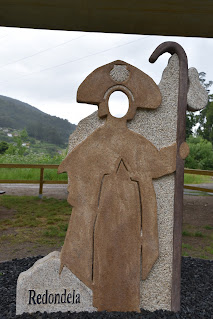
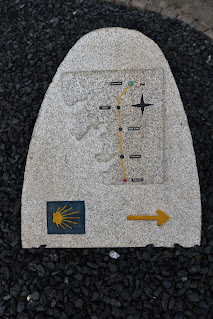
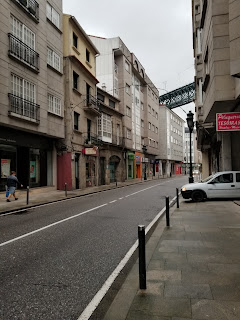












































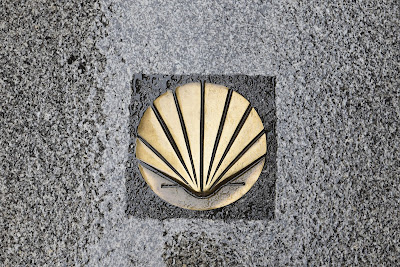






















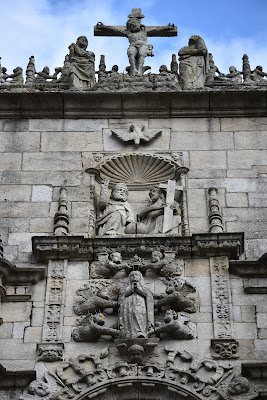





Comments
Post a Comment